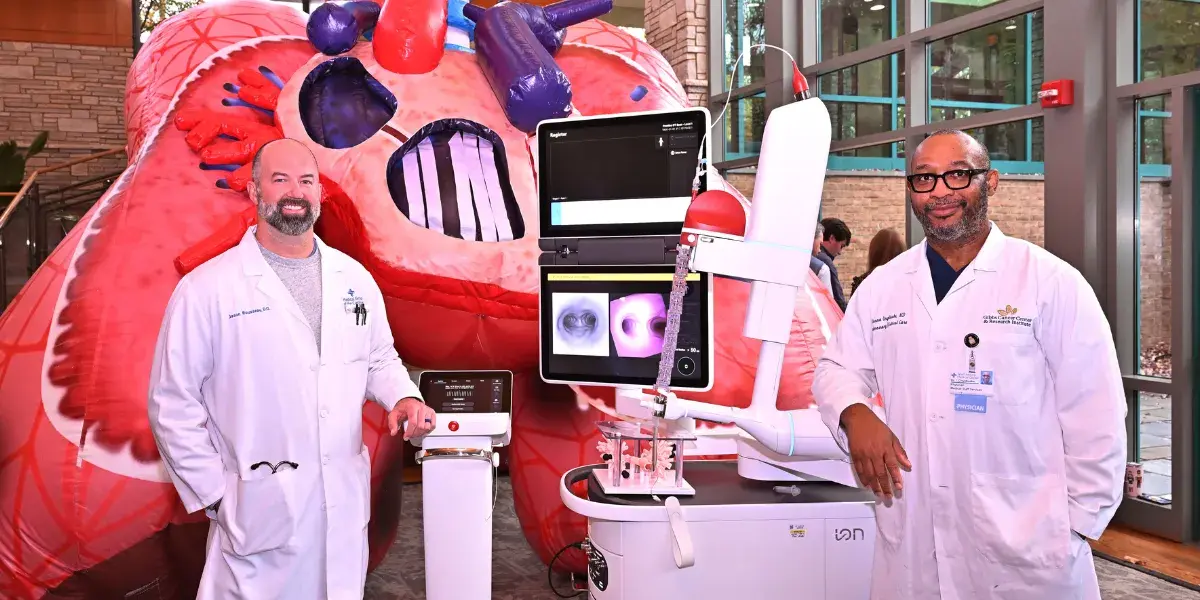
New robotic technology is helping doctors pinpoint early-stage lung cancer
New robotic technology is helping Gibbs Cancer Center providers detect and diagnose early-stage lung cancer – one of the latest efforts to improve patient outcomes.
Gibbs Cancer Center recently introduced its new ION Robotic Bronchoscopy device. The robotic-assisted platform allows for minimally invasive lung biopsies. When hard-to-reach nodules are detected through a CT scan, physicians can access them with greater precision through smaller air passages.
The system gives physicians greater stability and accuracy. Previously, smaller and harder-to-reach nodules were detected through CT scans and monitored over time for growth.
With treatment options available for stage 1 or stage 2 cancers, patients have a much better chance of survival, said Chad Dingman, director of oncology support and integrative medicine at Gibbs Cancer Center.
“It’s giving patients more opportunities for early detection and intervention,” he said. “If you can find early-stage cancer through our technology like our new robot, we can diagnose you and have a lot more treatment options. It’s all looking at resources for early detection.”
If cancer is detected during a biopsy, patients can then work with their physician team to determine the right path forward for treatment, which could include surgery, chemotherapy or radiation.
Utilizing the new ION system to detect smaller nodules in a minimally invasive way is just one way Gibbs Cancer Center’s lung program is making significant strides.
Through low-dose CT screenings, more than 5,000 screenings are conducted each year to detect lung cancer earlier than ever. A new AI-powered tracking software also helps identify hundreds of incidental lung nodules.
Cancer navigators and providers are also guiding patients through every step, from screening to treatment, with empathy and expertise.
Dingman said patients should first consult with their primary care physicians to determine whether to receive a low-dose CT scan, which uses less radiation than traditional CT scans.
Gibbs Cancer Center began using these advanced scans in 2018. Eligible patients must be 50 to 77 years old and have a 20 pack-year smoking history.
Dr. Amy Curtis, Gibbs Cancer Center’s medical director, said adding something like the ION device is all about accuracy.
“When we do a biopsy, we get results whether it’s cancer or not, and this helps us be more accurate in getting those biopsies in the correct location,” Dr. Curtis said. “So instead of two or these procedures, they can get one procedure, and it will give us the answer we need.”
As a physician for more than 20 years, Dr. Jason Rousseau said he is excited about Gibbs Cancer Center’s lung program efforts that are moving toward better patient outcomes.
“With the way the technology works, it’s like driving through the airways of the lung by GPS,” he said. “Really what gets me enthusiastic about this technology is diagnosing lung cancer at an earlier stage, which will ultimately have greater survival. If we can get to these nodules earlier, patients have a better shot at better outcomes.”
To learn more about the ION robotic technology or Gibbs Cancer Center’s lung program, visit SpartanburgRegional.com/services/cancer/lung-cancer-program.
Early detection of cancer can significantly improve patient outcomes. Speak with your primary care provider today about eligibility for a low-dose CT screening.












